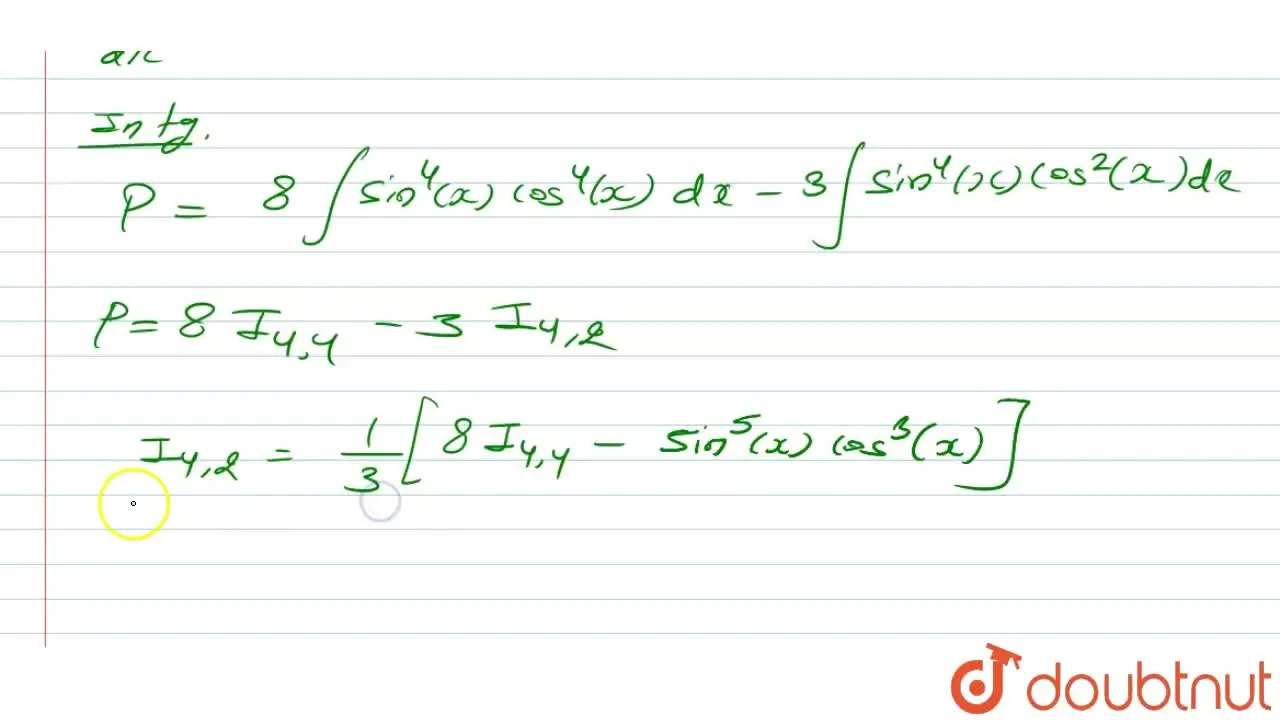Let Im,n=∫sinnxcosmxdx. Then , we can relate In,m with each of the following :
(i) In−2,m (ii)In+2,m
(iii) In,m−2 (iv)In,m+2
(v) In−2,m+2 In+2,m−2
Suppose we want to establish a relation between In,m and In,m−2, then we get
P(x)=sinn+1xcosm−1x ...(i)
In In,m and In,m−2 the exponent of cos x in m and m−2 respectively, the minimum of the two is m - 2, adding 1 to the minimum we get m−2+1=m−1. Now, choose the exponent of sin x for m - 1 of cos x in P(x). Similarly, choose the exponent of sin x for
P(x)=(nH)sinnxcosmx−(m−1)sinn+2xcosm−2x.
Now, differentiating both the sides of Eq. (i), we get
=(n+1)sinnxcosmx−(m−1)sinnx(1−cos2x)cosm−2x
=(n+1)sinnxcosmx−(m−1)sinnxcosm−2x+(m−1)sinnxcosnx
=(n+m)sinnxcosmx−(m−1)sinnxcosm−2x
Now, integrating both the sides, we get
sinn+1xcosm−1x=(n+m)In,m−(m−1)In,m−2
Similarly, we can establish the other relations.
The relation I4,2 and I4,4 is
I4,2=13(sin5xcos3x+8I4,4)
I4,2=13(−sin5xcos3x+8I4,4)
I4,2=13(sin5xcos3x−8I4,4)
I4,2=13(sin5xcos3x+6I4,4)
The correct Answer is:B
Step by step video & image solution for Let I_(m","n)= int sin^(n)x cos^(m)x dx. Then , we can relate I_(n ","m) with each of the following : (i) I_(n-2","m) " " (ii) I_(n+2","m) (iii) I_(n","m-2) " " (iv) I_(n","m+2) (v) I_(n-2","m+2)" " I_(n+2","m-2) Suppose we want to establish a relation between I_(n","m) and I_(n","m-2), then we get P(x)=sin^(n+1)x cos^(m-1)x ...(i) In I_(n","m) and I_(n","m-2) the exponent of cos x in m and m-2 respectively, the minimum of the two is m - 2, adding 1 to the minimum we get m-2+1=m-1. Now, choose the exponent of sin x for m - 1 of cos x in P(x). Similarly, choose the exponent of sin x for P(x)=(nH)sin^(n)x cos^(m)x-(m-1)sin^(n+2) x cos^(m-2)x. Now, differentiating both the sides of Eq. (i), we get =(n+1)sin^(n)x cos^(m)x-(m-1)sin^(n)x(1-cos^(2)x)cos^(m-2)x =(n+1)sin^(n)x cos^(m)x-(m-1)sin^(n)x cos^(m-2)x+(m-1)sin^(n)x cos^(n)x =(n+m)sin^(n)x cos^(m)x-(m-1)sin^(n)x cos^(m-2)x Now, integrating both the sides, we get sin^(n+1)x cos^(m-1)x=(n+m)I_(n","m)-(m-1)I_(n","m-2) Similarly, we can establish the other relations. The relation I_(4","2) and I_(4","4) is by Maths experts to help you in doubts & scoring excellent marks in Class 12 exams.
Related Playlists
- BOOK - ARIHANT MATHS ENGLISHCHAPTER - INDEFINITE INTEGRAL EXERCISE - Exercise (Single Integer Answer Type Questions)12videos
INDEFINITE INTEGRAL
- BOOK - ARIHANT MATHS ENGLISHCHAPTER - INDEFINITE INTEGRAL EXERCISE - Exercise (Subjective Type Questions)14videos
INDEFINITE INTEGRAL
- BOOK - ARIHANT MATHS ENGLISHCHAPTER - INDEFINITE INTEGRAL EXERCISE - Exercise (Statement I And Ii Type Questions)4videos
INDEFINITE INTEGRAL
- BOOK - ARIHANT MATHS ENGLISHCHAPTER - HYPERBOLAEXERCISE - Hyperbola Exercise 11 : Questions Asked in Previous 13 Years Exams3videos
HYPERBOLA
- BOOK - ARIHANT MATHS ENGLISHCHAPTER - INVERSE TRIGONOMETRIC FUNCTIONSEXERCISE - Exercise (Questions Asked In Previous 13 Years Exam)8videos
INVERSE TRIGONOMETRIC FUNCTIONS
Similar Questions
Let Im,n=∫sinnxcosmxdx. Then , we can relate In,m with each of the following :
(i) In−2,m (ii)In+2,m
(iii) In,m−2 (iv)In,m+2
(v) In−2,m+2 In+2,m−2
Suppose we want to establish a relation between In,m and In,m−2, then we get
P(x)=sinn+1xcosm−1x ...(i)
In In,m and In,m−2 the exponent of cos x in m and m−2 respectively, the minimum of the two is m - 2, adding 1 to the minimum we get m−2+1=m−1. Now, choose the exponent of sin x for m - 1 of cos x in P(x). Similarly, choose the exponent of sin x for
P(x)=(nH)sinnxcosmx−(m−1)sinn+2xcosm−2x.
Now, differentiating both the sides of Eq. (i), we get
=(n+1)sinnxcosmx−(m−1)sinnx(1−cos2x)cosm−2x
=(n+1)sinnxcosmx−(m−1)sinnxcosm−2x+(m−1)sinnxcosnx
=(n+m)sinnxcosmx−(m−1)sinnxcosm−2x
Now, integrating both the sides, we get
sinn+1xcosm−1x=(n+m)In,m−(m−1)In,m−2
Similarly, we can establish the other relations.
The relation between I4,2 and I2,2 isView SolutionLet Im,n=∫sinnxcosmxdx. Then , we can relate In,m with each of the following :
(i) In−2,m (ii)In+2,m
(iii) In,m−2 (iv)In,m+2
(v) In−2,m+2 In+2,m−2
Suppose we want to establish a relation between In,m and In,m−2, then we get
P(x)=sinn+1xcosm−1x ...(i)
In In,m and In,m−2 the exponent of cos x in m and m−2 respectively, the minimum of the two is m - 2, adding 1 to the minimum we get m−2+1=m−1. Now, choose the exponent of sin x for m - 1 of cos x in P(x). Similarly, choose the exponent of sin x for
P(x)=(nH)sinnxcosmx−(m−1)sinn+2xcosm−2x.
Now, differentiating both the sides of Eq. (i), we get
=(n+1)sinnxcosmx−(m−1)sinnx(1−cos2x)cosm−2x
=(n+1)sinnxcosmx−(m−1)sinnxcosm−2x+(m−1)sinnxcosnx
=(n+m)sinnxcosmx−(m−1)sinnxcosm−2x
Now, integrating both the sides, we get
sinn+1xcosm−1x=(n+m)In,m−(m−1)In,m−2
Similarly, we can establish the other relations.
The relation between I4,2 and I6,2 isView SolutionLet In=∫π/20sinnxdx,n∈N. Then
View SolutionLet In=∫π0sin2(nx)sin2xdx, n∈N then
View SolutionLet In=∫π/20cosnxcosnxdx. Then, In:In+1 is equal to
View SolutionIf I(m,n)=∫10xm−1(1−x)n−1dx, then
View SolutionIf Im,n=∫10xm(lnx)ndx then Im,n is also equal to
View SolutionIf in I2Cl6 the number of covalent bonds and coordinate bonds are m and n respectively. Find the sum of m+n
View SolutionIf Im=∫(sinx+cosx)mdx, then show that mlm=(sinx+cosx)m−1⋅(sinx−cosx)+2(m−1)Im−2
View SolutionIf Im,n=∫(sinx)m(cosx)ndx then prove that Im,n=(sinx)m+1(cosx)n−1m+n+n−1m+n.Im,n−2
View Solution


